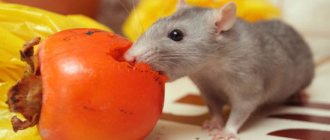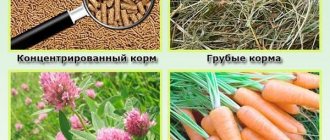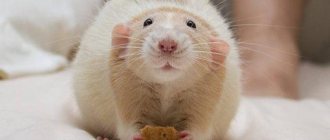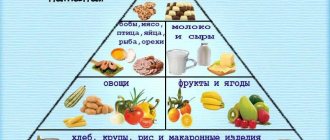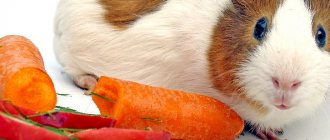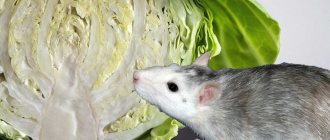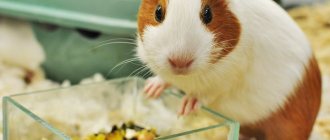Rats make amazing pets. It is not surprising that their owners do everything to ensure that the animals live longer. And the basis of rat well-being is not only good living conditions, but also proper feeding.
Previously, people didn’t think much about what they fed their pet rats. It's a rat! They are omnivores, indestructible, can eat soap, cardboard and sawdust, so why bother with them... As a result, the rats received either a “hamster diet” consisting of a single grain mixture, or a “pig ration” - they were simply given everything from the table. Both approaches are fundamentally wrong.
Properly feeding a rat is not so difficult, you just need to avoid harmful foods and try to maintain a balance of proteins, fats, and carbohydrates. Author of the article: Olga Shiltsova, practicing veterinarian, author of the books “Dachshund of Fate” and “Tails of Fortune”
Foods that should not be given to rats
If your pet's health is important to you, do not feed it from the table. It seems that there is nothing wrong with giving a rodent a piece of apple, chicken or cracker, but this is not so. The rat may refuse its food and instead receive a high proportion of fat and carbohydrates. It will be difficult to wean an animal accustomed to a common table, which means the end of a balanced diet.
It is strictly forbidden to give your rodent alcohol, fried, smoked, salted, pickled, fatty foods, carbonated drinks and sweets.
What to feed a little rat
A mother rat feeds her offspring with milk. However, there are times when she does not want to do this. In this case, responsibility for the life of the offspring will fall on the shoulders of the animal owner. To feed baby rats, you can purchase a lactating female at a pet store or feed the babies yourself.
To feed babies, you can use a pet milk replacer. Dry soy baby formula diluted with a small amount of goat's milk or condensed milk is also perfect.
Important! Liquid formula can be stored in the refrigerator for no longer than 12 hours. The formula will need to be warmed up slightly
To feed your offspring, it is better to use an insulin syringe with an internal catheter at the tip. You can also take a pacifier made from pieces of cotton fabric
The milk mixture will need to be warmed up a little. To feed your offspring, it is better to use an insulin syringe with an internal catheter at the tip. You can also take a pacifier made from pieces of cotton fabric.
After each meal, you should pour boiling water over the items. To avoid the development of enteritis in young animals, it is worth giving small rats a course of Biovestin.
Below you can find detailed information regarding the principle of feeding animals by week:
- In the first 7 days of a rodent's life, it is worth feeding them every 120 minutes. liquid diluted milk formula. Closer to the 7th day of life, it is worth diversifying the menu with milk formula, to which a small amount of dry ground grain feed has been added;
- in the second week, the mixture for rodents can be diluted to a consistency that will resemble liquid sour cream. You will need to drink the mixture every 3-4 hours;
- in the third week of life, you can pour the food mixed with the mixture into a bowl. From 23.00 to 6.00 you can not feed the offspring;
- At 4 weeks, animals can be switched to dry food. From the 30th day of life, rodents should be given food that is familiar to adults. If desired, rat pups can be fed milk until the end of the second month of life.
Babies will need to be fed the mixture every 2 hours.
What menu should kids have? When choosing a diet for little rats over 4 weeks old, you should give preference to:
- dry grain;
- boiled chicken, turkey and fish fillets;
- cottage cheese;
- dill and cilantro;
- bananas;
- apples;
- wheat sprouts;
- oats;
- chicken egg yolks;
- boiled chicken and turkey liver.
Under no circumstances should children be allowed to indulge in:
- cucumbers;
- champignons;
- garlic and onions;
- tomatoes.
Note! When rat pups are fed milk by their mother, they can only be fed by the 21st day of life. It is best not to wean babies early from breastfeeding, which has a positive effect on strengthening the animal’s immunity.
Organizing the right diet for your beloved rodent is important; this will allow you to raise the animal healthy. It is important to give up the desire to pamper your four-legged friend with table scraps such as sweets and sausage, as this can provoke the development of various pathologies of internal organs
Grain and cereals
Grains are the main product in the diet of rats, but they are not equally important. Wheat is a rich, high-calorie product; it can be given to rats, but it must be taken into account that it must be supplemented with other components. The mixture may include oats, buckwheat, corn, rye, barley or pearl barley, rice, millet or millet. These grains are not equal. Buckwheat is a dietary low-calorie product, and corn, on the contrary. Oats should be added in small quantities; excess may cause fermentation. Refined rice is low in nutrition, so it's worth finding a wild rice blend or an unrefined version of the grain.
Semolina does not contain anything useful, so this product should be excluded from the diet. Barley or wheat cereals are suitable for porridges. Porridge is useful only for weakened, emaciated animals or young animals. Adult rats should only give them as a treat.
Diet composition
The basis of a domestic rat's diet is a grain mixture. It is better to choose a ready-made mixture than to create a menu yourself, adding ingredients in the correct percentage. Food can be given without restrictions; a rare rat will eat more than 30 g.
In addition to the grain mixture, it is necessary to add succulent feed to the diet. These are vegetables, herbs, fruits, salads. Protein should also be present in the diet. This is especially true during active growth, pregnancy or breastfeeding.
In addition, you can give your pet treats. These can be seeds, nuts, dried fruits. There should be a limited amount of treats in the diet; it is best to use them as rewards.
The diet looks something like this: grains (60%), vegetables and herbs (20%), meat and eggs (10%). The rest of the diet consists of fermented milk products and treats.
Vegetables and greens
Among vegetables, foods that cause fermentation are prohibited: white and red cabbage, Savoy and Brussels sprouts, as well as cauliflower. Rats can eat broccoli in small quantities. Strong gas formation is caused by radishes, turnips and radishes, as well as all types of legumes: beans, peas, beans and lentils
.
You should be careful when giving sweet peppers; some animals have the same reaction to it. You can sometimes offer boiled green beans if they do not cause gas in your pet. Carrots, zucchini, zucchini and pumpkin are delicious and healthy foods. Cucumbers in excess will cause diarrhea
.
Eggplants are only good when cooked; solanine in raw vegetables can cause poisoning. Artichokes can also only be given cooked. Potatoes will not bring any benefit to the animal
. In its raw form it is contraindicated for animals, but when cooked it acts as ballast. However, some rodents enjoy eating potatoes.
Vegetables, fruits and herbs should be given daily in small quantities - 10-12 g.
Dill, cilantro, parsley, basil and celery are healthy foods for animals and can be given every day. They are not only safe, but also help digest protein foods. Onions, garlic and wild garlic are not suitable due to phytoncides that irritate the gastrointestinal mucosa.
They should be given occasionally and in limited quantities. Acidic vegetables such as tomatoes, rhubarb and sorrel can also eat away at the delicate walls of a rodent's stomach. You should not give animals spinach either. Beets carry another danger - a laxative effect, they should be given carefully. Leaf lettuces that do not have a specific bitterness are generally suitable for animals.
Choosing food
The basis of a rat's diet is a grain mixture. You need to choose a trusted manufacturer who maintains balance when formulating feed. If you can’t find good ready-made food, it’s better to cook it yourself than to buy low-quality food, which consists of almost 80% oats. A complete diet should include oats, wheat, barley and rye.
It is better not to take food in a cardboard box, as it is stored in unsealed packaging, and if it was near chemicals, the rat can easily get poisoned. You only need to buy formulations in airtight packaging, and it is better to do this not in a regular supermarket, but in a specialized veterinary store.
You can buy not only grain mixture, but also granulated food. This food is similar in composition to regular grain food; it is purchased when the rat eats selectively, eating the most delicious food and leaving the grain untouched.
Fruits
All citrus fruits should be immediately excluded from the diet of rats due to acidity.
. Occasionally you can give a piece of sweet tangerine. Forest and garden berries must be sorted according to their acid level. Thus, cranberries, which are useful in many respects, should be given with caution because of their taste.
Sweet cherries are more suitable than sour cherries. Never give animals seeds from fruit trees or citrus fruits.
They can be poisonous to rodents. You should pay attention to the special properties of fruits. Chokeberry and bird cherry strengthen, and plum weakens. This must be taken into account when choosing food. Pear can cause fermentation in some individuals. Watermelons and melons can be given in small quantities and only in season, as they accumulate nitrates.
Dried fruits are too sweet and may cause fermentation. They should be given carefully, as a treat.
Other Features
From time to time you need to pamper your pets with treats; you can also use them as encouragement when training the animals. Walnuts, premium dry dog food, and fruit and honey sticks are considered healthy treats.
You can’t give sweets, chocolate, store-bought crackers and chips with a lot of salt, preservatives, soft fresh bread, smoked meats, unripe fruits, raw potatoes, radishes, turnips, beans, cabbage, peas, rhubarb, beans as treats, because they lead to increased gas formation, as a result the animals will have a stomach ache and may develop diarrhea.
It is worth keeping animals away from some house plants, since seemingly harmless greenery is poisonous to them. Prohibited plants include aloe, tulips, daffodils, fern, geranium, lily of the valley, plush, agave, kalanchoe, and horse chestnut. These plants are often found in the homes of owners, delighting with their beautiful appearance and fresh aroma, but in fact they are poison for baby rats and adult animals.
Dairy
The decorative rat eats dairy products with pleasure, but some animals have lactose intolerance. Regular milk should not be given to a rodent at all, but fermented milk in small quantities will not harm. However, you should not feed your pet rat sour cream, cheese or cream due to the high fat content of these products.
Animals benefit from cottage cheese, fermented baked milk, yogurt without additives and sugar, yogurt, kefir, acidophilus. All these products should have a fat content of 2-4%. Low-fat foods are less natural. “Sour milk” should be chosen with a short shelf life, preferably children’s milk or from farms.
Animal proteins
Twice, or even three times a week, animals are supposed to receive animal proteins. The following can be served at the table:
- boiled lean meat;
- hard-boiled chicken or quail eggs;
- mealworm, zoophobus (zophobas), gammarus;
- seafood;
- high quality cat or dog dry food.
From poultry, you can give chicken breast, but it is better to feed turkey, which is not fed with growth hormones. From ungulates you can take beef, lean lamb, and game. It is better to grind the boiled yolk with water so that the rat does not choke. You should not feed fatty pork and its derivatives to rats.
Store-bought beef should be soaked for 2-3 hours before cooking, and chicken should be boiled in several waters to remove harmful substances. Rats can suffer from allergies.
How to use scents correctly
In order for aromatic substances to have the desired effect, they must be used correctly. There are a number of rules that should be followed:
- Essential oils are placed in close proximity to animal burrows. The liquid must be applied to a cotton pad or napkin. You can smear the corners of the room. In apartments, it is recommended to add oils to the water for washing floors.
- Dried herbs will smell longer if they are placed in cloth bags and tied.
- Fresh plants quickly lose their aroma, so they need to be replaced periodically.
- Rodents quickly get used to some smells. It is worth alternating scents.
- For maximum effectiveness, several different herbs can be used together.
It is dangerous to use plants that are toxic and allergenic at home. It is better to give preference to herbs such as chamomile, mint, lemon balm.

